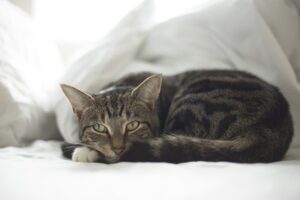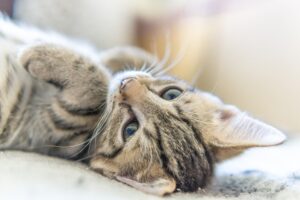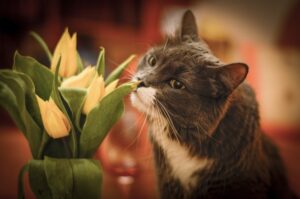
Some pet owners may not take the ingestion and mishandling of cats seriously, but it is, in fact, a very dangerous matter.
Cases of cats ingesting harmful substances without their owners noticing, leading to intestinal obstruction and even death, are unfortunately not uncommon.
Therefore, this article compiles essential information for times when you need to know about what is dangerous for cats to eat, what not to do when ingestion or mishandling occurs, symptoms and remedies for ingestion and mishandling, and more.
Table of Contents
1. Cats Prone to Ingestion and Mishandling
∟ 1-1. Especially Watchful for Kittens and Young Cats
∟ 1-2. More Common in Males than Females
∟ 1-3. Cats with Pica (Eating Non-Food Items)
2. Hazardous Items When Cats Ingest or Mishandle
∟ 2-1. String-like Objects
∟ 2-2. Medications and Drugs Causing Poisoning
∟ 2-3. Cat Toys may not always be Safe
∟ 2-4. Plants Dangerous for Cats
∟ 2-5. Foods Hazardous to Cats
3. Symptoms of Ingestion and Mishandling
4. What Not to Do When Ingestion or Mishandling Occurs
∟ 4-1. Inducing Vomiting
∟ 4-2. Pulling out Strings from the Rear
∟ 4-3. Giving Food
5. Response and Treatment for Ingestion and Mishandling
∟ 5-1. What to Do When Visiting the Veterinary Hospital
∟ 5-2. Treatment at the Hospital
∟ 5-3. Time is of the Essence in Cat Ingestion and Mishandling
Conclusion
1. Cats Prone to Ingestion and Mishandling

1-1. Especially Watchful for Kittens and Young Cats
Kittens and young cats, driven more by curiosity than caution, tend to engage in reckless and dangerous behaviors. This includes ingestion and mishandling incidents.
Ingestion and mishandling are more common in kittens and young cats, decreasing as they age. In particular, reports indicate that over half of cases involving plant poisoning occur in cats under one year old.
Cats, in general, are cautious about unfamiliar objects, but curious kittens and young cats may approach, play with, bite, and confirm by tasting. Therefore, it's crucial to either keep hazardous items away or hide them in places not visible to cats.
1-2. More Common in Males than Females
Ingestion and mishandling are said to be more common in male cats than in females.
Some theories suggest that this is because male cats are more curious, eat larger quantities, and have stronger biting power.
1-3. Cats with Pica (Eating Non-Food Items)
Cats sometimes develop an attachment to non-food items like blankets, strings, or plastic and exhibit behaviors such as chewing, licking, and eating. This is a type of eating disorder known as pica.
In the case of cats, behaviors such as sucking, chewing, and eating fabric or blankets are often observed, known as "wool sucking."
The causes of wool sucking may include early weaning, nutritional deficiencies in early life, or environmental issues during play. Digestive disorders can also be a contributing factor.
Regardless, these behaviors pose health risks, and pica can be life-threatening, so consult with a veterinarian if you notice such behaviors in your cat.
2. Hazardous Items When Cats Ingest or Mishandle

2-1. String-like Objects
Among the most dangerous items are thin, elongated "string-like objects." These pose a high fatality risk in cases of cat ingestion and mishandling, as they can lead to intestinal blockages, causing the intestines to become accordion-shaped and necrotic.
Cats' tongues are structured in a way that makes them prone to swallowing string-like objects. Therefore, string-like toys should be played with in areas where owners can supervise, and they should be put away after use.
Other dangerous items include plastic strings, hair, and yarn. Be especially cautious with plastic strings that make a crinkling sound, as many cats are attracted to them.
2-2. Medications and Drugs Causing Poisoning
Some medications and drugs intended for humans can be hazardous and cause poisoning in cats.
Particular attention should be paid to the following:
- ・Pain relievers containing acetaminophen
- ・Pain relievers containing ibuprofen
- ・Alpha-lipoic acid (supplements)
- ・Ethylene glycol (antifreeze, old coolants)
- ・Tobacco
- ・Essential oils
- ・Tea tree oil
All of these are highly toxic to cats and can be life-threatening. Among them, special attention is needed for alpha-lipoic acid, essential oils, and tea tree oil.
Cats may be attracted to alpha-lipoic acid, a supplement used for beauty and diet purposes. Some cats willingly eat it, and there have been cases of tearing open the bag and consuming it, so store it in a place out of reach.
Essential oils and tea tree oil can adhere to the fur when using aroma diffusers, and there is a risk of ingesting dangerous substances during grooming. Refrain from using these in homes with cats.
Additionally, ethylene glycol, which was once used in non-solid coolants, is now avoided for safety reasons.
2-3. Cat Toys may not always be Safe
Even cat toys require careful consideration. In particular, the following toys are considered to have a high risk of ingestion and mishandling:
- ・Those made with natural fur, such as rabbits
- ・Those made with natural feathers
- ・Toys resembling prey in size, such as mice
- ・Toys with small parts
- ・String-like toys or components
When choosing cat toys, opt for those without small parts, of a size that cannot be put in the mouth, and that are difficult to break. Be cautious with toys made with natural fur or feathers, as they can stimulate hunting instincts and increase the risk of ingestion and mishandling. There have been cases of ingestion and mishandling with mouse-shaped toys as well.
When playing with toys, do so within the owner's visible range, and put them away in a place out of the cat's reach after play.
2-4. Plants Dangerous for Cats
Cats cannot effectively detoxify plant toxins as they are carnivorous animals. Therefore, cats are said to show some reaction or symptoms to over 700 types of plants.
Examples include:
- ・Lilies
- ・Tulips
- ・Plants in the Araceae family (Spathiphyllum, Pothos, etc.)
- ・Plants in the Solanaceae family (Deadly Nightshade, Tomato, Morning Glory, etc.)
- ・Lily of the Valley
- ・Rhododendron
- ・Castor Bean Plant
Among these, lilies are highly toxic to cats. In particular, "True Lilies" and "Daylilies" are dangerous. Even just drinking water from a vase containing lily flowers or licking pollen stuck to fur can potentially cause poisoning symptoms and is extremely dangerous.
2-5. Foods Hazardous to Cats
There is a wide range of foods that are hazardous to cats. Particularly noteworthy foods include:
- ・Onions (including onions, green onions, garlic, chives, etc.)
- ・Chocolate (especially dark chocolate)
- ・Caffeinated beverages (coffee, tea, etc.)
- ・Alcoholic beverages
- ・Rose family fruits' seeds, unripe fruits (peaches, cherries, plums, etc.)
- ・Avocado
- ・Grapes
Onions and related items, such as garlic, are challenging to identify as they may be present in boiled broth and various dishes such as hamburgers and fried chicken. The seeds of rose family fruits and unripe fruits contain cyanide compounds, so be careful not to give them to cats.
In addition to these, citrus peel contains essential oil components, and excessive consumption of fatty fish can cause illnesses. Dairy products can also induce allergies or lactose intolerance. If cats are eating a balanced diet of cat food, there is no need to deliberately feed them human food.


